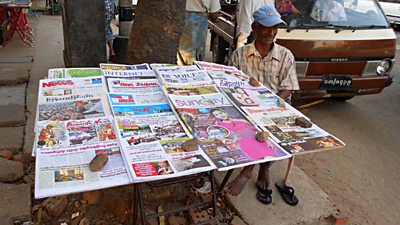Downloads
Research findings about the outlooks and attitudes of Myanmar's, also known as Burma, young people and the conditions under which its journalists work.
Publication date: July 2012
Summary
- 大象传媒 Media Action formed an innovative partnership with an international NGO to undertake audience research with young people inside Myanmar. The project enabled young volunteers to engage in peer-to-peer research in urban centres as well as conduct research with rural youth populations, a particularly hard-to-access and under-researched group in Myanmar.
- Urban and rural youth had varying access to media platforms and broadcasters. Urban youth had multiple sources for news stories and consumed more news and information, while rural youth had less access to news and fewer sources.
- Journalists working in Myanmar have adapted to working in an environment that is subject to high levels of regulation and a lack of freedom of expression by: self-censorship; finding different ways to frame a sensitive story; passing stories to contacts outside Myanmar and putting safety and protection measures in place in order to operate.
- Some journalism training was available in Myanmar, including on-the-job training; NGO and embassy-led training and one academic course. However, it was not comprehensive and did not meet the needs of journalists.
Context
In 2010, the first general elections in 20 years were held in Myanmar. Until then, Myanmar had been under the repressive rule of a military junta following a military coup in 1962. Since the elections, the new semi-civilian government has implemented a wide-ranging set of reforms as it embarks on a top-down transition from five decades of authoritarian rule and begins democratic reforms. Myanmar is geographically the largest country in Southeast Asia and is rich in natural resources but remains one of the poorest countries in the world. The media had operated under a highly restrictive and arbitrary system of regulation and censorship. Recently, there have been some signs of a relaxation of this censorship. But there is still a lack of variety and diversity of media platforms, broadcasters and formats for people in Myanmar to access in order to receive impartial and balanced news and information.
The project
The Burma Horizon project, funded by the US State Department and the Oak Foundation, aims to improve the access of the people of Myanmar to accurate, impartial and relevant news and information through an innovative new youth-oriented magazine-style radio show,Lin Lat Kyair Sin (Bright Young Stars), broadcast on the 大象传媒 Burmese Service. The project also aims to improve the quality of journalism training through online and face-to-face training for Burmese journalists based inside and outside of the country.
Research methodology
大象传媒 Media Action undertook research to inform the project鈥檚 programming and training outputs. The research explored the conditions under which Myanmar's journalists work, including the practicalities of operating as a journalist and the current level of journalism skills and training needs in the country. In-depth interviews were conducted with media experts and practitioners, and a questionnaire was administered to the 100 journalism trainees.
Discussions and participatory exercises were conducted with 15 groups of young people (five groups in urban and 10 in rural areas across Myanmar) to explore their lifestyles, outlook and news sources. Young people were asked about their media habits and what their ideal radio programme would sound like and gave feedback on a pilot episode of the programme.
Findings
Participants felt the media landscape in Myanmar is subject to high levels of regulation, a lack of freedom of expression and strict censorship. This has had an impact on the way in which journalists inside Myanmar can operate and how journalists outside Myanmar access and receive news and information from inside. Despite the measures journalists have taken to adapt, it is still extremely dangerous to operate as a journalist inside Myanmar due to the extreme punishments for those found to be in breach of severe legal restrictions.
Most journalists worked in print media, and there were a variety of training needs which depended upon a journalist鈥檚 background, skill and motivation. Their needs differed depending on whether they were working inside Myanmar or outside, in the exiled media.
Young people in Myanmar consumed news and information and trusted media broadcasters in different ways depending on their location. Whereas all rural youth listened to radio, most urban youth did not. Urban youth were much more likely to get news from multiple forms of media and multiple broadcasters, but rural youth had less access to news and used few media sources. Both groups identified education, justice and rights or opportunities as the most important issues to be covered in a radio programme aimed at people like them. Young people said they would like a programme which has a youth-oriented style, content and presentation with useful, practical information.
Implications and outcomes
Most journalists in Myanmar worked in print media and had little experience of working in radio production, which impacts on the co-ordination and targeting of training. As such, only a few trainees were sufficiently skilled to contribute programme content, although this will increase.
Programme makers have used the views expressed in the research as a source of ideas for programme content, as well as to inform its development and style. The audience research has yielded rich and insightful data on young people鈥檚 attitudes and their outlook on Myanmar, which will inform future projects.
